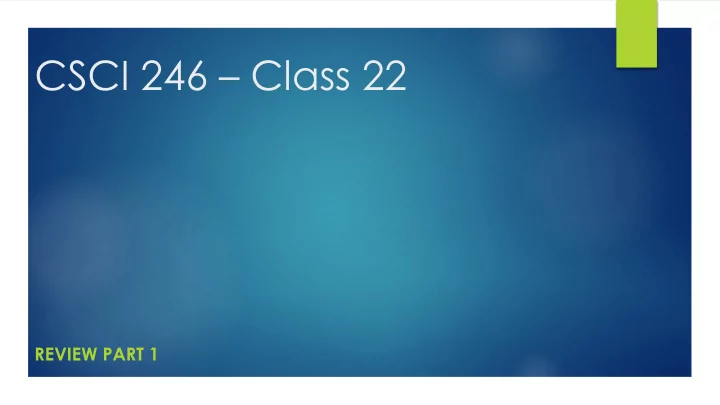

CSCI 246 – Class 22 REVIEW PART 1
Notes and Clarifications Final on Thursday
Propositional Logic Statements are sentences that claim certain things. Can be either true or false, but not both.
Logical Implications “If - Then” statements
Predicate Logic All men are mortal. Socrates is a man. · · · Socrates is mortal
Quantifiers and Limits Universal Existential
Direct Proofs The method of the proof is to takes an original statement p, which we assume to be true, and use it to show directly that another statement q is true.
Rational and Irrational Numbers An irrational number can be written as a decimal , but not as a fraction. An irrational number has endless non-repeating digits to the right of the decimal point
Divisibility and Quotient - Remainder Theorem It is a simple idea that comes directly from long division . The Quotient Remainder theorem says: Given any integer A , and a positive integer B , there exist unique integers Q and R such that A= B * Q + R where 0 ≤ R < B We can see that this comes directly from long division. When we divide A by B in long division, Q is the quotient and R is the remainder . If we can write a number in this form then A mod B = R
Unique Factorization Any integer larger than 1 can be factorized into primes
Greatest Common Divisor / Euclid’s Algo GCD : Greatest number that divides two numbers without leaving a remainder Euclid’s Algorithm: if m < n, swap(m,n) while n does not equal 0 r = m mod n m = n n = r endwhile output m
Asymptotic Notation Helps with questions like: How long will a program run on an input? How much space will it take? Is the problem solvable? Big O of n: O(g(n)) is an upper-bound on the growth of a function, f (n) Big Omega of n: Ω(g(n)) is lower -bound on the growth of a function, f (n) Theta of n: Θ(g(n)) is tight bound on the growth of a function, f (n ). http://eniac.cs.qc.cuny.edu/andrew/csci700/lecture2.pdf
Asymptotic Notation 1 (constant running time): Instructions are executed once or a few times logN (logarithmic) A big problem is solved by cutting the original problem in smaller sizes, by a constant fraction at each step N (linear) A small amount of processing is done on each input element N logN A problem is solved by dividing it into smaller problems, solving them independently and combining the solution
Asymptotic Notation N 2 (quadratic) Typical for algorithms that process all pairs of data items (double nested loops) N 3 (cubic) Processing of triples of data (triple nested loops) N K (polynomial) and 2 N (exponential) Few exponential algorithms are appropriate for practical use University of Arizona
Sequences and Series Sequences: an ordered list of numbers Series: is the value you get when you add up all the terms of a sequence
Mathematical Induction Mathematical induction is a method of mathematical proof typically used to establish a given statement for all natural numbers. It is a form of direct proof, and it is done in two steps. The first step, known as the base case, is to prove the given statement for the first natural number. https://en.wikipedia.org/wiki/Mathematical_induction
Homework (Group) Give the negation of “if I hit my thumb with a hammer, then my thumb will hurt” 1. Hint, it is not if I hit my thumb with a hammer my thumb won’t hurt 1. Of the following, which are rational? 2. 16 a) 9 2 b) 5 For the following, give the GCD: 3. (42, 56) a) Give the prime factorization for the following: 4. 48 a) 180 b)
Homework (Group) Directly prove that if n is an odd integer then n 2 is also an odd integer 1. Prove by Induction that for n > 1, 1×2 + 2×3 + 3×4 + ... + ( n )( n +1) = ( n )( n +1)( n +2)/3 2.
Homework (Group) The following is code for linear (non recursive) Fibonacci sequence at position n given below: 1. def LinearFibonacci(n): fn = f1 = f2 = 1 for x in xrange(2, n): fn = f1 + f2 f2, f1 = f1, fn return fn What is the Big – O notation of the time complexity for Linear Fibonacci? 2.
Homework (Extra Credit) The following is code for Recursive Fibonacci sequence at position n given below: 1. def fibonacci(n): if n < 2: return n else: return fibonacci(n - 1) + fibonacci(n - 2) What is the Big – O notation/time complexity of Recursive Fibonacci? 2.
Homework (Group) The following is code for Bubblesort is given to the right: 1. What is the Big – O notation of Bubblesort? 2.
Recommend
More recommend